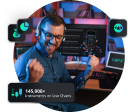"Over-Gamification Attracts the Wrong Traders," Swiset COO Warns on Prop Trading
Prop trading continues to develop as firms look to improve trader performance, adopt new technologies, and adapt to changing regional dynamics. At iFX EXPO International 2025, Finance Magnates’ Jeff Patterson interviewed Andres Jimenez, Co-Founder and COO of Swiset, about the firm’s recent moves in the proprietary trading space.
The conversation covered Swiset’s technology acquisition, the growing impact of futures and algorithmic trading, and the persistence of traders in Latin America.
Technology Acquisition and Shift in Focus
Swiset made a key strategic move in early 2024 by acquiring proprietary trading technology. According to Jimenez, this marked a change from focusing on dashboards and CRM tools to supporting the end users—traders.
“The basic is the end users—the traders. What are they doing? How are they trading? Are we giving them the right tools to trade better?” Jimenez said.
Swiset now prioritizes analytics powered by AI, aiming to support trader development rather than just increasing user numbers. Jimenez said many in the industry focus too much on acquiring new customers and not enough on helping traders improve.
Algorithmic Trading and Evaluation Challenges
Jimenez raised concerns about the rise of algorithmic strategies in the prop trading world. He noted that while some algos are designed to help traders succeed, others manipulate evaluation processes.
“Some algos help traders pass challenges, others exploit prop firms. Neither is good for traders or the industry,” he said.
He also addressed the trend in Latin America of using short-term algorithms to pass challenges that do not hold up in live trading.
“You pass the challenge, then lose the account. That’s not the idea—algos should improve traders, not ruin careers.”
You may find it interesting at FinanceMagnates.com: “Top Traders Master One Instrument”: Lessons from BK Trader’s Co-Founder.
Latin America’s Trader Mindset
Despite a global failure rate of around 80% in prop trading challenges, Jimenez said Latin American traders continue to try. He connected this persistence to both economic limitations and cultural determination.
“In Latam, you don’t deposit $5,000 easily. Someone might try a $100 challenge three times—but they won’t give up.”
He observed that many traders eventually move on to deposit directly with brokers after several challenge attempts, motivated by the potential of larger profits.
Differences Between Brokers and Prop Firms
Jimenez said brokers offer strong execution capabilities but often lack tools that help traders grow, such as journals and analytics. He positioned Swiset as a firm helping to close this gap.
On brokers entering the prop trading space and vice versa, he stressed the need for effective risk management. He believes AI can play a role in identifying committed traders.
“AI can help props filter serious traders from those just chasing payouts.”
Caution on Gamification
Jimenez also took part in a panel on gamification. He expressed concerns about applying the concept without considering the business model and target audience.
“A prop targeting leaderboard-driven traders attracts a different crowd than one offering $1M funding. Align your strategy with your goals.”
He compared competitive dynamics in institutional trading to gamified environments in retail but warned against going too far. “Over-gamification risks attracting the wrong traders.”
Final Remarks on Strategy
Jimenez ended the conversation by emphasizing that strategy must guide every part of the business.
“It’s not just marketing or tech—align everything. The strategy is the brand, and the brand is the strategy.”



